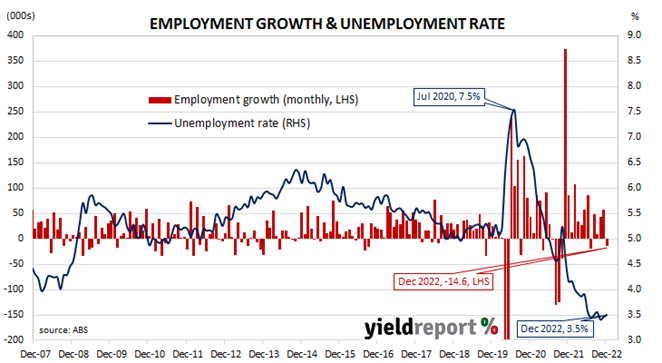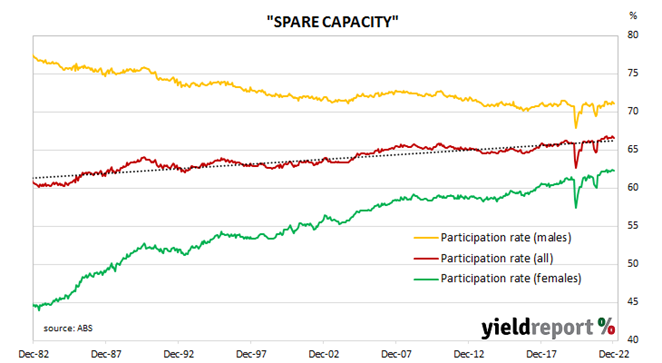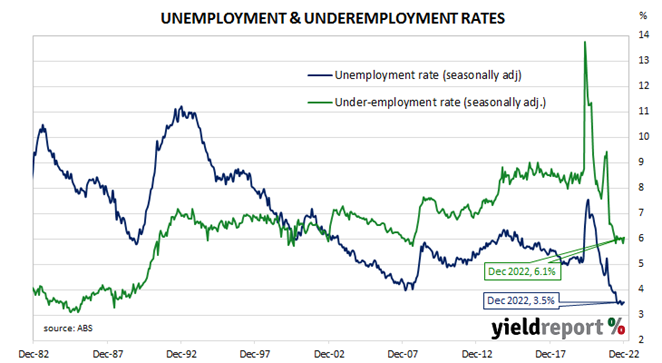Summary: Employment down 14,600 in December, contrasts with expected gain; labour market still “incredibly tight”; reduced hours due to illness up 50% on comparable December 2021 figure; participation rate declines to 66.6%; jobless rate steady at 3.5%; fewer part-time, more full-time jobs; aggregate work hours down 0.5%; underemployment rate increase to 6.2%.
Australia’s period of falling unemployment came to an end in early 2019 when the jobless rate hit a low of 4.9%. It then averaged around 5.2% through to March 2020, bouncing around in a range from 5.1% to 5.3%. Leading indicators such as ANZ’s Job Ads survey and NAB’s capacity utilisation estimate suggested the unemployment rate would rise in the June 2020 quarter and it did so, sharply. The jobless rate peaked in July 2020 but fell below 7% a month later and then trended lower through 2021 and 2022.
The latest Labour force figures have now been released and they indicate the number of people employed in Australia according to ABS definitions decreased by 14,600 in December. The fall contrasted with the 20,000 increase which had been generally expected as well as November’s 58,200 gain after revisions.
“The labour market remains incredibly tight, despite a slight upward revision to the unemployment rate to 3.5%,” said Citi Australia senior economist Faraz Syed. “Despite a decline in job growth in December, the economy still added 87,300 jobs in Q4. This suggests that it’s too early for the RBA to make a dovish pivot.”
Domestic Treasury bond yields fell considerably on the day, outpacing the overnight falls of their US Treasury counterparts. By the close of business, the 3-year ACGB yield had lost 22bps to 2.97%, the 10-year yield had shed 23bps to 3.33% while the 20-year yield finished 20bps lower at 3.73%.
In the cash futures market, expectations regarding future rate rises softened. At the end of the day, contracts implied the cash rate would rise from the current rate of 3.07% to average 3.19% in February and then increase to an average of 3.425% in May. August contracts implied a 3.525% average cash while November contracts implied 3.52%.
“There appears that a lift in illness could have been a drag on employment with the number of people working reduced hours due to illness increasing by 86,000 to 606,000 which is over 50% higher than we would usually see at this time of the year,” said Westpac senior economist Justin Smirk.
The participation rate fell back from November’s revised figure of 66.8% to 66.6% as the total available workforce decreased by 8,800 to 14.247 million while the number of unemployed persons increased by 5,800 to 499,800. As a result, the unemployment rate remained steady at 3.5%.
The aggregate number of hours worked across the Australian economy decreased by 0.5% as 32,200 residents lost part-time positions and 17,600 residents gained full-time positions. On a 12-month basis and after revisions, aggregate hours worked increased by 3.2% as 44,800 fewer people held part-time positions and 496,800 more people held full-time positions than in December 2021.
In recent years, more attention has been paid to the underemployment rate, which is the number of people in work but who wish to work more hours than they do currently. December’s underemployment rate increased from November’s revised rate of 5.8% to 6.1%, 0.3 percentage points above this cycle’s low.
The underutilisation rate, that is the sum of the underemployment rate and the unemployment rate, has a strong correlation with the annual growth rate of the ABS private sector wage index when advanced by two quarters. December’s underutilisation rate of 9.6% corresponds with an annual growth rate of about 4.6%.




